When mangrove jack get trapped in natural or manmade lakes and lagoons they have endless opportunities to feed and thrive in these environments, sometimes growing to trophy size.
This article will outline techniques to target big mangrove jacks that will work in all the landlocked waterways in South East Queensland.
The following story takes place in one such lake, a lake known by many as full of massive fish with a now dwindling population. This particular lake has a ban on cast and drag nets and is popular with families and anglers alike, it hosts a species list as long as your arm, at least it used to.
Some of the species include your usual bream, flathead and whiting, which don’t usually get the chance to grow too big due to fishing pressure, but there are some larger residents that reign supreme.
Over the summer months a few years back a few of the boys and I took it upon ourselves to target some of the monster mangrove jack that live in a mini ocean we found. Confirming stories of 70cm+ jacks was easy, two of us went for a snorkel one sunny day and were blown away by what we saw, approaching a concrete drain with undercut edges revealed half a dozen big jacks milling around, and they look twice as tough underwater, trust me.
One particular session we had already stopped and gathered our evening’s bait, consisting of live mullet 3-7” long from a nearby cane drain. Arriving at the lake to a setting sun, we fished the drain where we had seen the big jacks. McKee rigged his un-weighted mullet on bream gear spooled with 6lb braid and a 20lb leader. McKee has a knack of leaving his rod rigged from previous trips and manages to be first in the water 99% of the time but, being totally under gunned. after 3 seconds of screaming drag McKee was back re-rigging after his textbook smoking.
What takes place next is what can only be described as McKee’s moment to shine or one huge fluke or maybe just maybe a series of events that were destined to be.
McKee the sly dog was first in the water again and might I say in prime location, the rig is the same. only this time the bait is the largest of the lot and a 7” mullet does not stir McKee’s confidence. This resulted in McKee returning to his old school ways by casting out, putting his rod down and loosening the drag to wander off. He would have checked his bait twice in twenty minutes. This is not the preferred method of fishing a live, un-weighted mullet in a lake of big predators as the mullet don’t seem to like open water, preferring the sandy shallows.
McKee’s mullet did exactly this, swimming into the shallow sandy stretch near us. Upon returning the mullet to its optimum location, McKee placed his rod down and went to the car to grab a drink from the esky and what happened next was inevitable.
McKee’s bait got absolutely smashed about 2m out and in about a meter of water, the line started screaming from his tiny reel and he was nowhere to be seen. McKee finally bumbles on the scene and grabs his rod and gets taken for a ride. He has nothing but hopes and prays at this stage as the fish was hovering dangerously close to the concrete drain the extends out a good 5m underwater from where he was fishing.
After being smoked earlier he realised the useful benefit of his two feet and quickly moved away from the drain steering the fish into open water, the fish still took line at will and although in open water the violent head shakes and sudden bursts of power had McKee nervous. A stale mate became quickly obvious with line neither coming nor going and for several minutes it looked like McKee might succeed where many had failed.
A few more cranks of the reel and a mammoth jack slid onto the sandy shore, the wide gap hook securely embedded in the corner of its mouth.
Without a tape measure and an eagerness to return the tired beast to the water we can only estimate it at being well over 60cm and a definite trophy in anyone’s book and after a few yahoos and happy snaps the gorgeous jack was released to an unknown future.
Over the years I have had to refine all the tackle used to target jacks in a landlocked environment. This is partly because of pressure placed on the fish and also due to the still calm waters that lack current or any significant flow. Without current these jacks have time to swim right up and check out the mullet and with such still conditions big hooks rigged on bulky line and leader visibly stand out.
Choice of spin or baitcast gear comes down to personal preference and line class to suit can vary from 10-20lb as the light leaders used don’t allow the use of heavy drag pressure. At times leaders of 20lb and over can catch fish but to consistently entice strikes, leaders need to be as light as possible and I reluctantly have found the need to fish leaders of 12-15lb just to get hook-ups.
Hook size is also not what you would call ideal for the size of the baits used but after a lot of trial and error smaller hooks proved to be the most successful at raising strikes and securing hook-ups. The two styles I found to be most effective are size 1 octopus and size 6 wide gap and both are rather small which I find to be a crucial part of the rig. Don’t be concerned about light gauge hooks as the light drag pressure rarely straightens them out.
Fishing unweighted mullet is no new thing but there are a few sneaky little traits that mullet have when rigged this way that are worth knowing.
The two ways to rig a mullet can result in two totally different swimming patterns once cast out.
The first way you can rig a mullet is lightly pinned just behind the dorsal fin making sure not to damage the backbone. The second is pinned through the upper lip making sure the hook is only as far back as it needs to be and not through the head.
These methods of rigging unweighted mullet have two totally opposite and rather unusual outcomes. The most successful method is through the upper lip, but for some unknown reason when rigged this way the mullet turn towards the line and in a very short time end up swimming into the shallows at your feet.
The other method has a different reaction and the mullet, when rigged behind the dorsal fin, tend to keep tension on the line by swimming in the opposite direction of the tension and usually away from the angler. The latter requires less attention from the angler but more time is required for the jack to swallow the bait and get the hook in its mouth.
The first method needs constant attention as slack line needs to be retrieved and mullet need to be kept out in the strike zone, but when a strike occurs, hook-up rates are increased due to the hook placement.
One surprising capture was a juvenile Queensland groper. This one fish alone is enough to warrant conservation of the entire eco-system, but the scary thing is that this one fish may not even score a second glance before going under the knife due to people not knowing it is a protected species.
The biggest resident of this lake, rumoured to be a groper, no longer harasses the local ducks that dared to land on the lakes surface thanks to some fillet happy bad eggs. I first heard rumours from locals that there was a big groper living in the lake. One local had even seen it take ducks off the surface. The first encounter I had with this immense fish was underwater and when I stuck my head near the undercut edge of a concrete drain a massive tail was all I saw but I heard and felt the forces from the pressure wave given off by its powerful tail.
Sadly I heard from two different sources that it was caught and for some unknown reason killed. What a loss.
I’ve also talked to quite a few people who boast of catching and killing more big jacks than I would like to know about. One old timer laid claim to more than 20 jacks over 50cm and his best reaching 72cm.
These mini ecosystems have a lot to offer as the fish have the potential to grow to trophy size and can’t leave for life-cycle migrations as they would in a natural environment.
Some of the other target species worth chasing in the majority of lakes like this are tarpon and giant herring, which this lake has quite a few. If you know of this lake or one just like it take a moment to think about keeping what you catch along with the chance of heavy metal build up, which can occur in such lakes.
Think about how long the stocks will last, it’s only a matter of time till there gone.
Reads: 6559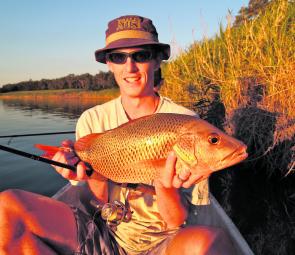
Jembo with a fine example of a land-locked jack.
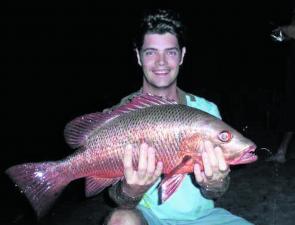
McKee's monster jack taken livebaiting a lake.
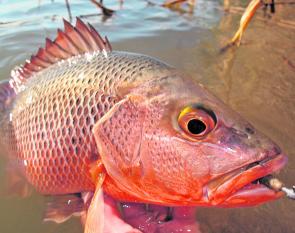
This land-locked mangrove jack ate an Ecogear Bream Prawn 40mm.
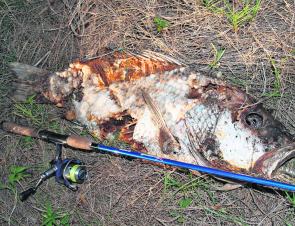
How's this for a washed-up, 80 odd cm of dead mangrove jack from a lake?
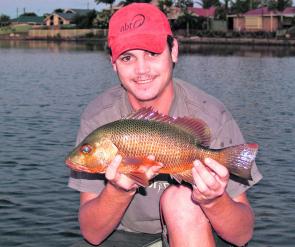
Shaun Fitzpatrick with a smaller lake jack.
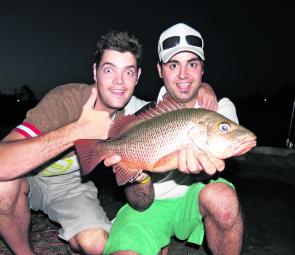
Two Matt's and one land-locked jack.




